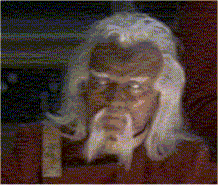

Ruler: Grandmarshall Lord Taran Soothra
Religious Ruler: Cardinal Rahasia Al'Vere
Chief Diplomat: Archmage Sultan Zyntax
City Spell: Sword of Love, Breath of Khalak
Population: 141,000 Citizens, Population Charts
| Indoctrinations to the Laws of Babylon | Sheriff of Babylon | Oath Stone | Codes of Chivalry |
| Public Safety | Alarms | Crimes | Rules for Citizens |
Babylon is a city in the Sea of Dust at the site of Tovag Baragu. Built upon the ruins of the Forgotten City and adjacent to the great concentric godstones used as portals to other lands and times, Babylon is at the center of the battleground in the war against the Dark One. Most importantly, though, it is the most holy site of the Church of Ishtar, the place where her avatar fell in battle against Terum Verostak the one-eyed, one-legged avatar of the Dark One, and where her blessed abundance and land of stability rescued all of Oerth from the Dark One's magic and renewed the area of the Sea of Dust around the battleground, pushing back the Reign of Colorless Fire (Tiamat's great punishment from the Age of Legends).
The city now stands as the site of some of the greatest wonders on Oerth, including the Hanging Gardens, the Tree of Life, and the Cathedral. It also represents holy ground to the thousands of dwarves who saw Theoden Rockbrother fall during the Final Battle and is a safe haven for the Queen of the Celene and her elvish people who were driven from the Wild Coast by orcs.
Despite the constant trials of its early months, Babylon has thrived. Those who dwell within the city claim that what does not kill them makes them stronger. The city has been threatened by demons, devils, daemons, Ketians, dragons, Suleiman warriors hiding in a dust storm, orcs, thrykeen looking for trade, dune stalkers, gigantic sand worms, and even a magic attack from the Horned Society. A vast collection of trophies lining the city walls attests to the city's growing strength.
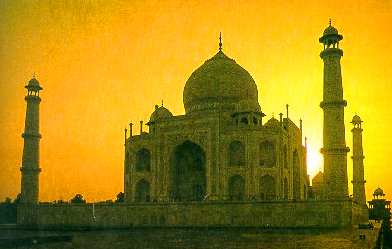
Babylon is probably the most diverse of all Nyrondian cities, home to elves, dwarves, humans, druids, high-stakes gamblers, gladiators and duelists, barbarians, Suleimen, mulls, and any number of desert races. Careful laws and cultural activities help keep inter-cultural relations among the population running smoothly, and gladiatorial pits and challenge circles for contests in battle do the rest. With Grand Marshal Taran Soothra's epic leadership, legendary commander feat, the Ring of the Shield Lands, and high charisma, he can command 48,000 first-level followers, so a large portion of the city maintains a ver high degree of loyalty.
Babylon's citizens (see Rules for Citizens), drawn to the religious significance of the city, must deal with the trials of living in the Sea of Dust. Most citizens are still zealous followers of the city's leaders, although increasing acceptance among their neighbors in the Threefold Land of the Sea of Dust and interest among other Nyrondians enticed by economic opportunity have brought some less loyal within the city walls (Read the first-person perspective of wall guard).
Strict rules for worshippers and guests alike are absolutely necessary to ensure the safety of all within the city. Welcoming committees relate the city spirit as well as water policies, and indentured servitude to the ranks of the welcomers and even worse, city scouts helps keep the city jails empty. Fear of Lord Taran Soothra's Judgment ability, a gift from Shammash to the long-time wielder of Lawgiver, chases the most unworthy from the city altogether.
Among the citizens are members of various groups with whom the church of Ishtar has developed strong alliances, including Ishtarian Druids and other druids interested in the Tree of Life; Chendelian blacksmith priests who provide Gibbil's Fire in the weapon forges; and the many Ansharian clerics who have taken refuge within the city walls until their cities may be re-secured from Ketians or Barbarians who hold them now. In return, these clerics aid in the everyday affairs of the church, taking confessions, protecting the city and blessing its inhabitants with good dreams.
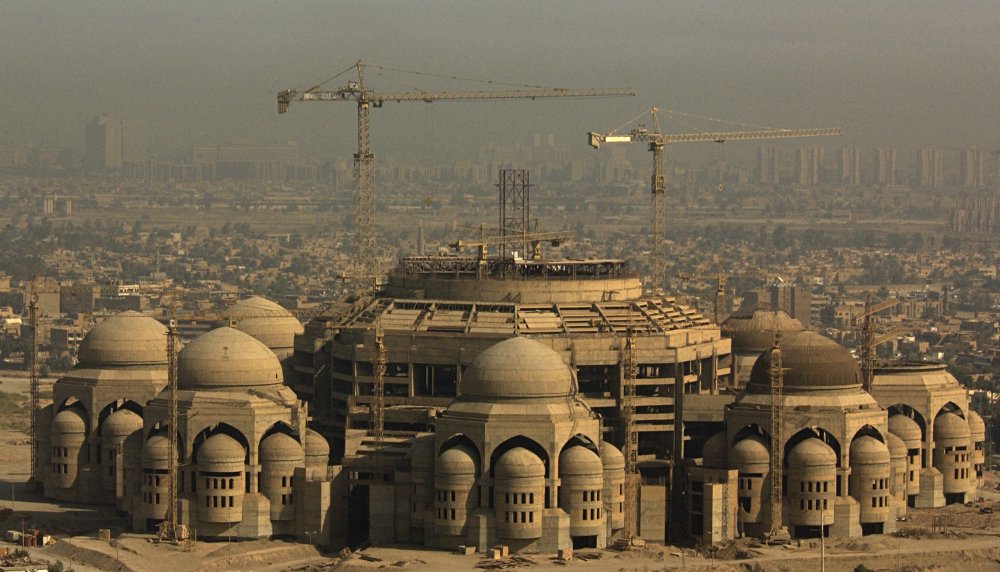 Yr 3
Yr 3 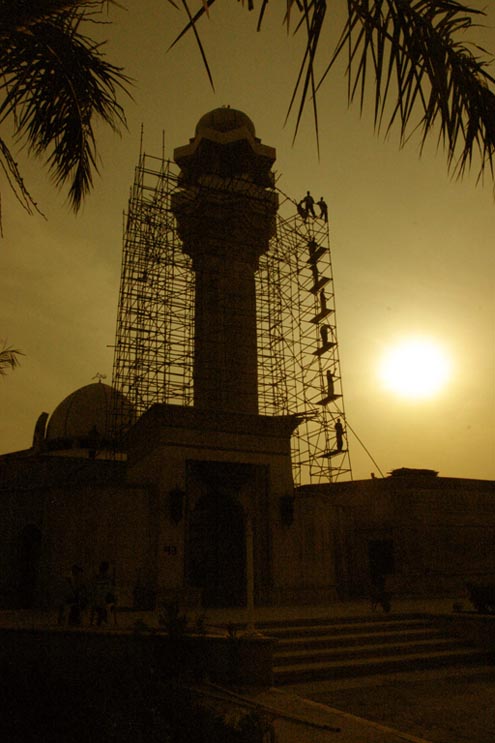
The city is of dwarven craft set to an immaculate human-conceived architecture. Three or four thousand, strong-armed dwarven laborers were employed under the faithful superintendence of Sultan Zyntax. Work proceeded at a furious pace, with the inspiration of both Ishtar and Theoden Rockbrother to drive them on. It is said that Archmage Zyntax was inspired by the very hand of Ishtar as he drew the plans. The buildings usually have thinner bases and larger almost bulbed rounded tops which come to a point--often with many balconies or windows (each which may be shuttered in case of sandstorm).
Fascinating and innovative architecture fits the needs of this diverse city. Many of the buildings have open balconies and colorful awnings. The entire city is ringed with a double-wall through which city defenders can pass and make tactical retreats, cornering aggressors within it. The tallest structure is, of course, the Cathedral whose central dome is over 200 feet in diameter. Within the city, permanent structures cool off by constant jets of air moving through Sultan’s air conditioning pipes which also serve as air-based sewage control. Druids and mages are working to recycle the waste for use in fertilizing and maintaining the Hanging Gardens as well.
The north
side of the city features the delicate structures of an elvish palace,
the home
of the Queen of Celene in exile from orcish occupation of her lands.
The ruler's compound at the end of the city is both palace and citadel, as big as a great city itself. The guards positioned high up in the battlements above the gates proclaim the arrivals and departures of the Kararkairn and other notables by the beating of several pairs of drums, the clashing cymbals and the long, bass notes of the karna. The roaring sound can also be stunning as it announces an outgoing army, and it is at once solemn, grand, and melodious. (**NOTE: Some descriptions of the city and its various landmarks are adapted from the Mugal Histories, which describe the actual Taj Mahal and the city of Akbar which surrounds it.)
The city wall is a double wall edifice of close to forty feet high. The great height is necessary to break the brunt of sandstorms which rise frequently and quickly from the desert. A grand road runs in between the two walls (which are spaced about 35 ft apart). This road that circles the city between its walls is used for troop movements as well as a secondary defense post if the first wall is breached. Hashamash, Master of the Walls, and chief of the city's defenses, can be found in a keep set between these walls at the entrance to the city from the desert.
Almost all walls and buildings are made from the same brownish stone which is rumored to have been mined directly from the elemental plane of earth by the dwarves. The stone slabs in the walls are so joined together that the end of a hair could not find a place between them. Pilgrims visiting the city claim that the stones of the buildings are so cunningly fitted that the joints are scarcely visible, although no lime was used to fix them together. The beautiful color of the stone which is all reddish-brown also produces the same effect of uniform solidity.
In fact, the stone walls of Babylon are made of elemental earth and mixed with anti magic dust. These walls are resistent to magic as if an anti magic field was present. These block all spells and magic that would pass through them. Outside exposed stone walls in some sections are covered in creeper, this living vine prohibits ethereal creatures from passing the boundary. iron doors are usually thick enough to block most detect spells, such as detect thoughts. Wooden walls, wooden doors, and stone doors are usually not thick enough to do so. However, a secret stone door built into a wall and as thick as the wall itself (at least 1 foot) does block most detect spells.
The walls are provided with four gates whereby the doors of the dominion are opened to the four quarters of the world. At the gate from The Ways is the seat of the Sheriff and Chief-Justice in matters of law. Near this station is the office of the vizier and Census Taker who sits every morning some three hours by whose hands pass all matters of rents, grants, lands, firmans, fees, taxes, debts, etc. Flanked by statues of lions, the gate to the desert is called Hathi Pol. A passage within the Waybridge Gate leads to the west and to the munitions store.
Babylon is a very odd place, I must say. The hodgepodge of cultures and races make it uniquely interesting but also difficult to manage. An especially difficult task for Taran is handling relations between wetlanders and haqdeshani delicately. Suleiman culture is largely based on the harshness of life in the Onesh, where all creatures face challenges from everywhere just to live another day. Your typical wetlander has no appreciation or understanding of what in means to try to live in these conditions and for this reason the constant state-sponsored indoctrinations are really necessary. While noble savages they may be, most haqdeshani lack any appreciation for the art of magic, sword fighting, politics, religion or Oerthian culture. This is something Taran and Rahasia and Sultan are bringing to them and also trying to get them to accept the extinguishing of the ROCF, eventually. What helps Taran the most in ensuring peace between the various cultures in Babylon is the desert itself. The necessity of cooperation that the desert exacts to even survive makes the job of imposing rule a lot easier. Food and shelter are in the cities, and the threat of exile or expulsion into the desert as a powerful motivator to gain cooperation. The ROCF's effects, in a way, compel individuals to obey laws and respect order and ironically that serves Taran. Taran regards the irony of the Reign of Colorless Fire helping him in some ways as a blessing. When he sees ways it helps him, he feels it is Ishtar using the enemy's power against her. Part of Taran's philosophy of the "true" meaning of the Onesh is that it compels all creatures in an area to work together and endure hardships together, to have purpose in their actions and movements, to obey absolute laws and to become stronger (by fighting). This is reflected in the way Babylon civil society and government is set up: Taran, Rahasia and Sultan work together to maintain the city. The haqdeshani and wetlander cultural struggle is kind of a reflection of how Taran looks at himself. While he tries to fulfill his destiny as the legendary messiah of the haqdeshani, he imagines that other Soothra must have done the same thing to entire peoples, maybe nations long ago. When reflecting on his early days, Taran guesses that Dallben had a good idea of who and what he was long before it was revealed to Taran. In The Book of Three, Dallben was able to see the future - that is, a certain future - if certain things were to come to pass so he ensured Taran was prepared for certain things. The Soothra aspect of Taran gives him reason to conquer and rule even without religious or political motivations. When Taran stops and thinks deeply about how Kas regards him, and what he's doing, he learns this not-too-clever poem from his past:
The context of the fight with the Dark One at Tovag Baragu and her subsequent defeat has a different context for Taran in regards to his lineage:
The sky is the clearest of blue, and immeasurably large. Standing on the balcony of a treehouse within the Hanging Gardens, it is as if visitors are on a mountaintop and can see for days. The sky, from this vantage point, almost seems to be eating the city up, as if this small dot on the landscape of noiseless endless dunes and an unyielding yellow desert could be swallowed by the sand or plucked up by the sky and vanish without a trace. Looking out over this great expanse makes viewers feel small and certainly isolated, yet calm. The setting sun lends to that calm and as the sky takes on a reddish hue viewers can sense an obvious change in the desert. Far away the moon is on the rise and viewers almost catch a glimpse of something else in the sky, far, far on the horizon. The sun has not completely set, however, and as eyes lower to fall upon “The Rim,” the tops of the great walls that surround the city, the sudden surge of colors and designs brings viewers back into the world of the living.
The city is always abustle. Large insects, each bigger than a man are herded and tended on farms, just inside the walls. Along a fence surrounding the farm, under the shadow of the wall and protecting them from the scorching sun, people move in lines. Each stops at the fence, pauses for a moment, and leaves the busy square with large chitin pottery on their backs. Elsewhere, rounded tops of the towers decorate the city, complete with large verandas and balconies colored with linens, tapestries, banners and or crests, a feeling of vibrancy is apparent. So many people from so many different civilizations obviously cohabitate, but there appears no segregation of the cultures. A clearly dwarvish banner might be next to the Aerdian colors of old or a Greyhawkian crest next to one of the many Taranite, Soothravian, Finerioite or Hachdashani banners. Even the Hucharachi banners co-mingle throughout the city.
Still though, some things stand out. The glass works to one end of the city, the fat parapets of the School of Politics and Shadow and the many academies behind it, and of course the massive bridge descending into the city from the sky, The Ways. A thoroughfare from the rings of Tovag Baragu into the center square is often crowded with chunks of stone being delivered through one of the portals. And interspersed throughout the city are still many structures under construction, surrounded by dwarvish builders, artisans, and stoneworkers busily following the architectural plans said to be given to Sultan as a divine gift from Ishtar herself.
The elves in exile from the Celene have acquiesced to the city planning long ago and have enclaves of communal structures throughout the city, with the Queen’s personal retreats in the Hanging Gardens and her royal reception chambers and courts in the city proper.
Kothlun’s old
quarters within the church next to
Charrissa’s bedroom (Al'Vere’s
daughter) include his
painting studio, and Alexander's home
crafted from the husk of a
defeated Tarrasque stand in the glassblowers
district.
Babylon is not yet central to most Haqdashani trade routes, but trade with the elves and thrykeen provide goods for trade with the other Ishtar cities on the mainland of Nyrond and Furyondy, as well as with Barbarians and other groups. Traders soon find that bards and storytellers have better luck in the markets than those who are unable to tell the tale of their wares. Buyers will find the most exotic goods from the deserts, including rich paints, bird-like Crodlu (the desert horse, a social animal intelligent enough to form intricate communities and paid in coin), Kanks (a large beetle used as a mount, beast of burden, and source of kank nectar, a honey-like water substitute), spices, crystals and gems.
Most food still comes from trade over the Waybridges, through Chathold, or from Suleiman herds, but the rich and fertile soil surrounding the battleground, gardens and tree grows yearly. The Grainhouses see use from desert crops yearly, and a growing cadre of druids has helped the bounty of the harvest and the plants' ability to adapt to their harsh surroundings.
The markets are off of the center circle of the city, close to the entrance to The Ways. Among them is a solitary stone building which houses the Sheriff of Babylon. Around this building and its stables and barracks are set the markets. The markets are all free standing tents which may be up at any time, although night is when the market is most active. These tents (see below) hold mercantilers from many places on Oerth - most strongly represented by desert cities or cities on or close by an entry to The Ways. Prices can be somewhat different from those in the "wetlands."
Despite its distance from most Nyrondian cities, it can still be said that all roads lead to Babylon. The great stone roads in the sky that led the armies of Ishtar to the final battle connect voyagers and pilgrims from Greyhawk City, Chathold, Dyvers and the Theocracy of the Pale, bringing them to Babylon for much more peaceful visits in much less time than most can travel from Rel Mord to Dyvers.
Unique to Babylon, two completed roads allow entrance to the city. One road, reserved for dignitaries and heavily guarded and protected, sets down outside the gardens. On the other, regular travelers meet the scores of welcomers who explain safety regulations about magic, water, printed materials, bearing weapons, and the oath of chivalry, as well as providing a reminder of the sacredness of the city. A third way stands in ruins as if severed from the blows of the Sword of Siege (Stonecutter). At this site Lord Finerio McBaine severed the bridge to head off an attack by demons and undead at the beginning of the battle at Tovag Baragu. When the demon force came up the road, he wielded Stonecutter , the only sword that can cut The Ways. He left the demons to fall in the debris. The road's favorite moment was when The Ways touched down at Tovag Baragu. It was made to bring all to the fight against the Dark One, and at that moment it was fulfilling its purpose.
Sights En route to Babylon on the Ways
Two 18-ft. tall lion-headed creatures with metallic skins (iron golems). There are four knights on horses accompanying them. Their symbols are a pair of antlers on a golden background (Knights of the Hart). They warn of a number of thieves traveling the ways.
Crodlu with two haq’deshani riders command travellers to get out of the way. Thrykeen have been sighted on the Ways, and they are hunting them to keep them from infesting the forests and jungles of Oerth.
Pilgrims, merchants from Greyhawk City, and a Companion's Entourage can often be spotted. Those travelling out of Babylon comment that the city is both bustling and dangerous and inspiring and glorious. The Haq'deshani can be very dangerous and pick fights any chance they get with those who carry swords.
While visitors and pilgrims are still high up on the bridge, they can see citizens on the balconies of the taller buildings. The church and city are filled with elemental earth stone and anti-magic glass.
Descending down into Babylon, there are tons of sand and desert, more sand than anyone from the "wetlands" of Oerth has ever seen.
On The Ways near the gates (though high enough to be outside the environment of the desert) may be found the Welcome Stations. The Welcome Station at the gates from the Sea of Dust is tailored to Hachdeshani and staffed by those who speak the language.
Each new guest stands upon a large red carpet which removes curse and makes anything magical glow. The Welcomers and Indoctrinators are indentured servants and professionals who are responsible for seeing that all who enter the city are aware of its laws and customs.
Among the most urgent are the prohibitions to open water, water elemental spell casting, any other connections to water, and printed writing due to the effects of the Reign of Colorless Fire.
In addition, anyone desiring to carry a sword openly within the city MUST take an Oath of Chivalry on the Pattern Magic Oath Stone (administered by a cleric of Ishtar). The purpose of this last requirement is two fold - one to honor Ishtar, the Queen of Swords, and the other to manage problems arising from differences in customs (the desert people react violently to swords in general and the Chivalric Codes require anyone who carries a sword to accept any challenges presented to them in the Challenge Rings or put the sword away).
Sultan's school has studied the colorless fire and written several books on the subject. It appears to be an intelligent pattern magic made up of several complexly woven patterns. Its complexity shows that the device that created it had to be spawned by Tiamat herself. The Colorless Fire ignites water it also senses connections to the water plane and will act to try to destroy that connection - at one point Sultan had set up a very special portal that could reverse time when the colorless fire sensed the connection so he could close it before a big explosion. Eventually the colorless fire attacked the device that did the temporal management even though it had no water component to it. It was also discovered that the colorless fire will burn INFORMATION and knowledge. Writings, books, or anything containing history and knowledge seems to be especially explosive.
While the pattern magic itself does not draw on other planes, a property of all pattern magic, it does summon powers of ash & negative material plane. Mages have worked to produce a cloak or circlet that, upon the victim burning for more than 1 rd, eradicates all air in 1ft radius. Once person stops taking fire damage, it stops. This would mean a sustained burn (not a quick fireball blast) would set it off and it would be detecting the person taking damage NOT the fire. Since Prot. v. Fire doesn't actually help against the colorless fire, there's no reason for the fire to waste time on metal when it has ready access to water (in the body). Clerics and mages have used the whole lightning rod idea to combat colorless fire, sort of a "burn lure" to something we're willing to lose so we can escape. For all its intelligence, the colorless fire does have to follow some rules of its nature-it needs air to burn, for instance, and can be smothered. The strong, tightly woven, worm silk cloaks and worm silk blankets of the Haq'deshani serve as good fire extinguishers. There are stations filled with blankets throughout the city.
A large above-sand harbor exists for a small fleet of Cloudships (some supplied by Furyondy) and Sandskiffs. The docks rise about 20 feet above the sand and are heavily guarded. These are used for city defense as well as tours for visiting dignitaries; the fleet of desert ships affords great tactical advantage to Babylonian forces under the command of Martin Mingus, Admiral of the Southwestern Fleet.
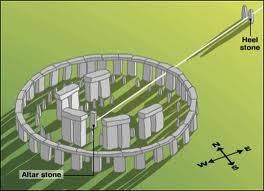
Hanging among the concentric godstones of Tovag Baragu, the gardens attest to the fertility Ishtar brings to the desert. This is the ground where Ishtar’s avatar fell and where the Avendasora Tree now stands. Winding among and around the concentric godstones of Tovag Baragu lies this paradise-like garden measuring 368 yards square and abounding in various kinds of fruit-bearing trees and rare aromatic herbs. Each of its bounty-laced flower-beds is pleasing and hart-captivating like the flower-beds of the garden of the keeper of Paradise. Its attractive green trees are perennially fed with the water of life through the very ground on which Ishtar’s avatar fell. The stature of each tree, in respect to both quantity and quality, by every reckoning surpasses that of the celestial Lotus tree. Four walkways are laid out in the middle of the garden, which are each 40 cubits in width. In the center of the garden there is a platform surrounded by anti-magic glass, and in the midst of it is the Tree of Life. The excellent features of this Paradise-like garden—such as its pathways fashioned entirely of elemental stone—have reached a stage surpassing imagination. Along both the eastern and western sides of the garden there is a portico, 11 yards in length and 7 in width, furnished with two rooms. At the rear of the portico there is a chamber 9 cubits long by 5 wide, and in front a platform 46 yards in length and 10 in width. The northern side of the garden is entirely filled with multiple porticoes formed by the godstones. At the eastern and western corners, two lofty towers have been constructed, furnished with heart-pleasing seat-alcoves.
The Hanging Gardens have three large buildings and many guards at the entrance. These are the Grainhouses, and they themselves are guarded by 20 militia, 40 muls, and 6 paladins with the symbol of the lion rending the unicorn.
The gardens are valued at 85,000 gp in rare plants just six months after their planting. The gardens include a baby agrafari tree, one of the desert trees that grows in the Sulhaut Mountains. These trees do not burn, and preservers use these as magical fulcrum because they hold life energy well. By July 583 (YR4), Babylon will have a small agrafari grove in the gardens.
There are also three trees from the Barrier Peaks (6 ft. trunk, 70 ft. tall, 40 ft. canopy).The gardens include Thrommel Roses, all the King's favorite plants and flowers, one or two of each fruit tree, Logorious’s plants collected in shadow, plants of the Celene, rare plants from the Wild Coast (pre-orcs), three special plants from old Onwall, talking grapevine, plants given by each of Rahasia Al'Vere’s people on her wedding day, golden corn from seed given by the Grand Druid, wheat from seeds found in the Sea of Dust, the Rose of Forgiveness, goodberry bush that makes 9/day and carries a maximum of 50 berries.
Talking Grapevine running from the stones throughout the city walls and buildings spreads rumors throughout the city, both true and self-fabricated in an effort to prevent attacks from other planes as well as to disarm the Dark One of her power over secrets.
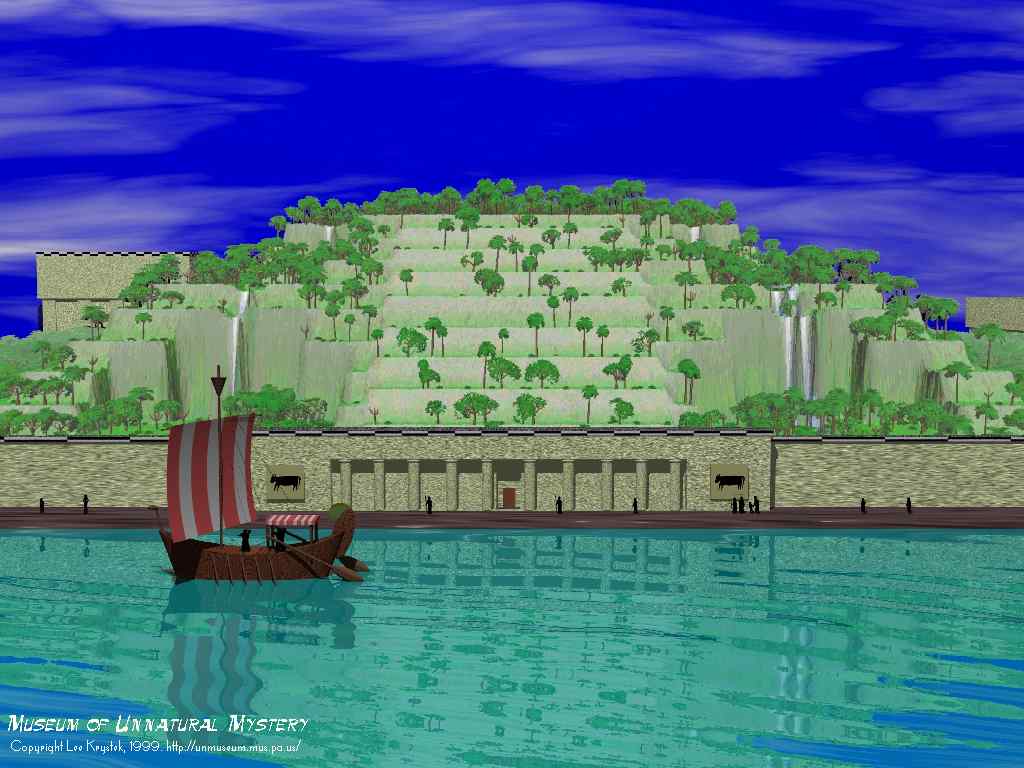
Given
freely from a branch of
the One
Tree, the Avendasora, hidden away by Morgus the Dragon in his city of
Colorless Fire, 60 weeks northwest from
Tovag, the young Tree of Life is
the centerpiece of the lush city gardens. It is the precious Gilden
Tree,
different from
the tree that grows in the Celadon Forest. Carefully guarded by great
and ancient magics, glass
viewing panels, paladin protectors, druids and clerics, this tree stops
the incursion of evil forces from the outer planes. The
Archbishop Al'Vere,
Starrider, Lord Cothlun, and the Grand Druid
combined
their efforts to
locate
and attain the seedling. Planted while the original Elcrys in the
Celadon Forest was felled, and the world
suffered from demon attacks, the
tree also represents hope for growth and greenness for the Nyrondian
dwellers
of Babylon as well as the elves and
Preservers who tend it as well. No one can die within the area
of the tree. Chirissa,
the Archbishop Al'Vere’s daughter, was
born under the branches of
this tree and can often be seen playing
around its trunk.
The tree is protected by a permanent Merdox insect ward, hurt loam, and a permanent protection from magical weapons, Nine Wards of Earthpower of the Grand Druid, and an ancient Balcuni Silouese Pattern Magic Scroll of Protection passed on through the centuries by Preservers in order to guard the tree. Only clerics, druids or their authorized guests may enter the actual grounds of the Tree of Life. Endangering or harming the Tree is a major crime in Babylon.
Home to Sultan's school, Babylon enjoys the comforts of access through rifts to a wide variety of inner planes, including the first portal opened by Sultan Zyntax himself directly to a mine on the Elemental Plane of Earth. In addition, diplomats from the school serve as advisors in city business and intelligence. They also travel through nations, shadows, and planes to negotiate contracts and magical patents.
The School of the Politics and Shadow is run by Master Sultan Zyntax. The entire school is devout to Ishtar and attends services. Sultan will be returning from a battle when daylight comes. The guard at the school is Anachi. With Taran's Compound, the school and the church complex form a triangle, and the school has a cool smell from its various planar connections.
Sherelle (Shanyrria Ryllae Aelorothi) an elf from the Gnarly Forest is a cleric/mage who works with both Sultan’s school and the church. I 16, W 13, S 8, Ch7, C13, D 11, etiquette, read/write/sculpting, astrology, politics, mathematics, teaching, religion, psionic openThe School features the Circle of Planar Rifts, The Logos. Highlighting the center of these rifts, water feeds into a spiral waterfall held on sculptural wall of air around a 40,000 gp statue of Ishtar
Teleport circles and Dimensional Interlinks are crafted by the School of the Ways.Spells (such as a teleportation circle) transport characters to some other location in the dungeon or someplace far away. They can be traps, teleporting the unwary into dangerous situations, or they can be an easy mode of transport for those who built or live in the city, good for bypassing barriers and traps or simply to get around more quickly. A detect magic spell will provide a clue to the presence of a teleporter, but direct experimentation or other research is the only way to discover where the teleporter leads.
A 200 ft diameter
horizontal
disk made of bronze is located under the School
of Politics
and
Shadow. The disk was recovered
from an attack on the city made by the Horned
Society. Now, Babylon's own
indentured
servants continually turn the disk
by walking in a large circle. Various mages of the School have pieces
of the
bronze disk and can use its movement as a source of constant kinetic
energy
throughout the city.
Stiletto Jim’s Casino is also off the
main square near the church. The most famed gambling house on Oerth,
high
stakes gamblers from around the continent and beyond come to the
casino,
waiting for a chance to pit their own skills against the notoriously
lucky
Stiletto Jim. Others just want to watch the excitement, always
surprised by the
lineup of musicians available. Some have even seen Jim or the famed
Zeppelin
play. And, of course, the Champions of Sophora, including even Finerio
McBain, Lord Soothra
and the Archbishop Al'Vere
herself, sometimes stop in to wine and
dine
with their friend Jim.
Ser In'eluke is often in the casino with two halfling protectors, and
Jim, disguised in the form of Lord
Kron, Zepplin’s old henchmen from Hookhill
The
Casino is also home
to the Sightblinder
Guild of Thieves (Jim’s spy club).
Coming
out of the kitchens
are trays with exotic foods--Jim boasts that you can get anything you
want at his casino. House specialties include: BBQ pork pigs with
apples in their mouths, earth temple
bread, fire
temple chili, water temple soup, air temple popped corns, Goldskull
brats,
elemental node hot dogs.
Designed at first for the ritual wrestling of lions necessary for all young paladins to go up in rank, these arenas now attract gladiators from Rel Mord, duelists from Leukish, and fighters from across the globe who come to meet the challenge of Babylonian champions and desert gladiators in the pits. On Sappatu the arenas are filled with lion fights, the great magical Festival of War, chariot races, fights against desert creatures and thri keen warriors, captured halflings, and contests against noted Nyrondian gladiators.
They are huge, roughly the size of the Colloseum in Rome, and for major events, Tantalos uses his illusions to project close-up details of the battles or re-enactments into the highest reaches of the stands.
In YR4, a number of citizens pool together resources to create a statue of the First Champion (Alexander) to decorate the arena. Any lawful good character who studies and respects the statue gains the Victorious feat for the day.
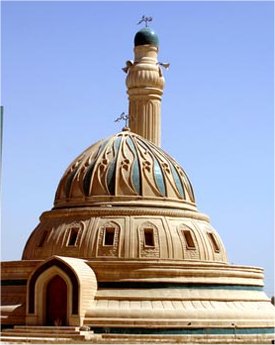
Where plants cannot grow in the dust of the desert, the church promotes fertility in the desert animals made stronger and more powerful through many generations in the Onesh due to the Pattern of Evolution beneath the Crescent Forest which has promoted quick, beneficial evolutionary effects in all creatures of the Sea of Dust. For instance, the sacred Lion prides of the Lion Kennels are tended by Ishtar clerics and Ishtarian druids. Merchants maintain other farms like the Crodlu (intelligent desert steeds) and Kank beetles (for water source).
Nibeney Inn is a two-story building run by a haq’deshani with gems in his nostrils. There’s no magic within 10 ft. of him. Haq’deshani have anti-magic shells. The rooms are underground where it’s cool.